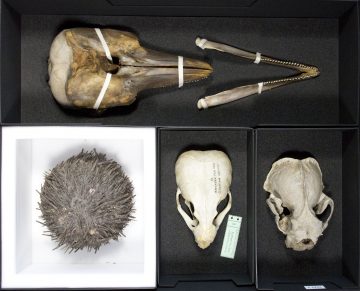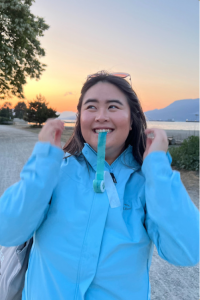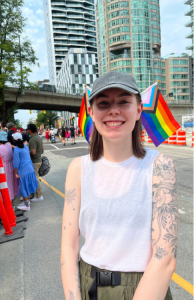New Sea Cucumber Species Identified in the Marine Invertebrate Collection
The Marine Invertebrate Collection Curatorial Assistant, Sheila Byers, has had the great pleasure of working with Dr. Francisco Solis-Marin, an expert taxonomist specializing in Echinoderms—the spiny-skinned invertebrates of our oceans. Francisco is on sabbatical from the National Collection of Echinoderms, Universidad Nacional Autónoma de México (UNAM) in Mexico City. For the past six months, Francisco has worked through our wet (alcohol-based) and dry specimens of sand dollars, sea urchins, sea biscuits, sea cucumbers, sea stars, brittle stars, basket stars examining more than 1,000 specimens and identifying more than 90 species. These specimens were collected in the past from all over the world from England to Antarctic.
The sea cucumbers, however, are Francisco’s favourite group of echinoderms. Sea cucumbers, shaped like the cucumber vegetable are an odd shape compared to the other groups of echinoderms. The sea cucumbers generally crawl about the seafloor using their tube feet, somewhat like the sand dollars and urchins.
To his great surprise, Francisco found a new species of sea cucumber (Epitomapta aumakua) in the collection. The species name for the new cucumber aumakua, refers in Hawaiian mythology, to a person or family god that originated as a deified ancestor, who takes on physical forms as spirit vehicles.
ZooKeys 1183: 73–80 (2023)
DOI: 10.3897/zookeys.1183.111620
It is not a large cucumber, less than 2 cm in length. The specimen label identified the collection from Kualoa, O’ahu, Hawaii in a habitat as coarse sand and shallow depth of 2.5 m. By comparison, our local BC giant California cucumber (Apostichopus californicus) reaches 50 cm in length and found at depths from intertidal to 247 m! Regardless of size, there is one very important difference between these sea cucumbers—tube feet (podos)! The giant cucumber uses tube feet on its underside to crawl along the seafloor. The cucumbers lacking tube feet are apodous cucumbers. The new species is an apodous cucumber. Most of the apodous cucumbers burrow and feed within the sediments as opposed to crawling on top of the seafloor sediment.

Young giant California. Image source: Washington State by Dave Cowles, http://rosario.wwc.edu/inverts

Tube feet on undersurface of cucumber. Image source: Washington State by Dave Cowles, http://rosario.wwc.edu/inverts
On examination of the small MIC cucumber specimen, Francisco immediately recognized some of the external morphological characteristics. In 2019, he described a new species, Epitomapta simentalae, from the Central Eastern Pacific coast of Mexico. But could this species be from Hawaii such a distance away!?

“Epitomapta simentalae”, a larger cousin of E. aumakha.
Characteristics of E. aumakua, like the tentacles, body wall and papillae were different. Delving deeper with microscopic examination, he saw distinct differences in the shapes of the anchors in the body wall that the cucumbers use to move in the sediment. They were very distinctive when magnified using electron microscopy as shown in this Figure 1.
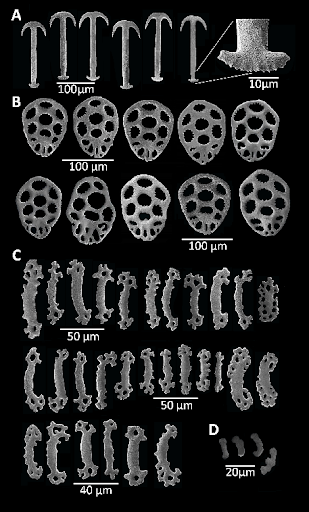
Figure 1. “Epitomapta aumakua” sp. nov. Holotype MI 4942 A anchors from mid-body, showing the detail of the posterior part B anchor plates from mid-body C rods from tentacles D miliary granules from the body wall.
*Colección Nacional de Equinodermos “Dra. Ma. Elena Caso Muñoz”, Laboratorio de Sistemática y Ecología de Equinodermos, Instituto de Ciencias del Mar y Limnología (ICML), Universidad Nacional Autónoma de México (UNAM), Mexico City, C.P. 04510, Mexico.
Gertrude May Smith: Pioneering Woman in Science at UBC
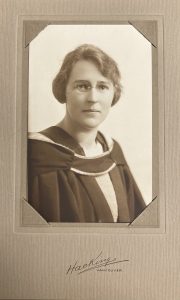
Dr. Gertrude May Smith, 1902-1986. UBC BA Biology 1923; UBC MA Biology 1926, UCal Berkeley PhD 1934. (Photo credit: 1926 Graduation image from UBC archives.
In the annals of history, there are certain individuals whose names may not be widely recognized but whose contributions have left an indelible mark on their fields. Gertrude May Smith is one such figure. As the first woman to join the Faculty of Science at the University of British Columbia (UBC) in 1930, Smith blazed a trail that would inspire generations of scientists to come.
Born at a time when women’s opportunities in academia were limited, Smith defied the odds and pursued her passion for biology with determination and resilience. Her journey at UBC began in the 1920s when she embarked on her undergraduate studies, culminating in a Bachelor of Arts in Biology in 1923. But Smith was not content with just a degree; she immersed herself in the world of scientific research, working as a Lab Instructor while pursuing her Master’s degree.
It was during her graduate studies that Smith’s fascination with salamanders took root. Venturing into the wetlands of Stanley Park and beyond, she meticulously observed and collected specimens, laying the groundwork for her future research. In 1926, armed with her Master’s degree, Smith set her sights on the University of California, Berkeley, to pursue a Ph.D., a degree not yet offered at UBC.
At Berkeley, Smith delved deeper into her studies, focusing on the nasal region of American salamanders—a topic that would form the basis of her doctoral dissertation. Her dedication and expertise earned her recognition from prestigious scientific societies, further cementing her reputation as a formidable scholar.
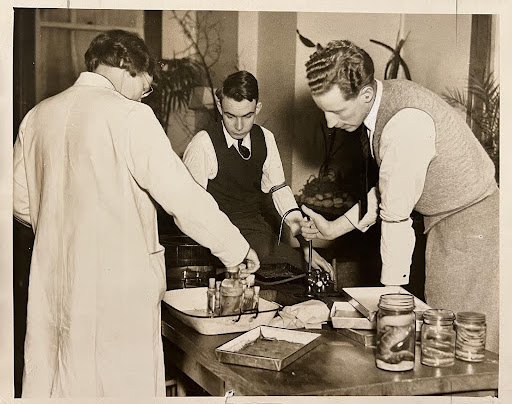
Gertrude M. Smith, circa 1933, in a labcoat inspecting specimens with students in the UBC Zoology Department.
In 1930, even before completing her Ph.D., Smith made history by becoming UBC’s first female faculty member in the Faculty of Science. Her appointment as an Assistant Professor was a groundbreaking moment, breaking down barriers and opening doors for women in academia. Despite the challenges she faced as a trailblazer, Smith thrived in her role, teaching courses in Zoology and continuing her research on salamanders.
However, Smith’s time at UBC was not without its difficulties. In 1939, her contract as Assistant Professor was not renewed, leaving her without a job and explanation. Speculation swirled about the reasons behind this decision—was it the societal norms of the time, the changing focus of the Zoology Department, or the lack of published material from her Ph.D. dissertation? The truth may never be known, but Smith’s resilience in the face of adversity is undeniable.
Although her academic career was cut short, Smith’s passion for the natural world endured. Her legacy lives on through her daughter, Muriel J. Harris, who followed in her mother’s footsteps, pursuing a career in zoology at UBC. Smith’s influence also extends to her grandsons, who continue the family’s connection to UBC through their own academic pursuits.

Gertrude M. Smith, seated, with students in her 1931 lab. In the back row on the right is Ian McTaggart Cowan, founder of the Cowan Tetrapod Collection. The models and jars suggest this was a comparative morphology lab.
Beyond her scholarly achievements, Smith’s dedication to her craft is evident in the meticulous detail of her work. Armed with nothing more than a manual typewriter and her keen intellect, she produced elegant diagrams and scholarly manuscripts that stand the test of time.
Today, Smith’s contributions to science are preserved in the Cowan Tetrapod Collection at UBC, a testament to her enduring legacy. As we celebrate her pioneering spirit and unwavering determination, let us remember Gertrude May Smith as a trailblazer who paved the way for future generations of women in science.
Read more about Dr. Gertrude May Smith and other contributors to the Cowan Tetrapod Collection here, and check out the newest display window at the Beaty Biodiversity Museum.
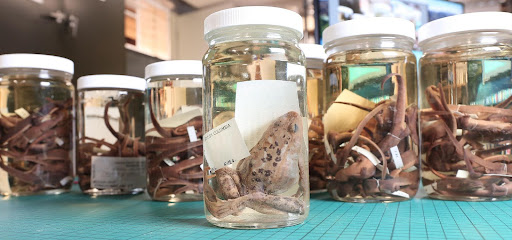
Specimen H000437 is one of a pair of Columbia Spotted Frogs collected in 1926 by Gertrude M. Smith from near New Denver, BC, where she was born and lived until she came to UBC in 1919. The CTC has just under 50 specimens of this frog; Smith’s specimens are the oldest. (Photo Credit: Nola Moray)
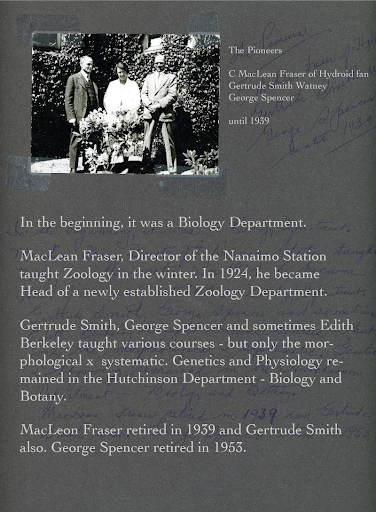
UBC Department of Zoology History, zoology.ubc.ca/about/department-history

From left to right: UBC Zoology Professor Dr. Judith (Judy) Myers, UBC Zoology Professor and daughter of daughter of G. M. Smith Dr. Muriel Harris, and Collections Curator of the Cowan Tetrapod Collection Ildiko Szabo. Photo by Christine Weiss
Research by Ildiko Szabo, Muriel Harris (daughter of G. M. Smith), and Douglas Harris (grandson of G.M. Smith).
Donate Today: Click the box for Beaty Boxes!
For almost 10 years, Beaty Boxes have been bringing the Beaty Biodiversity Museum into classrooms and community spaces. Genuine, touchable museum specimens set Beaty Boxes apart from other outreach kits, stimulating inquiry and discussion and enhancing learning experiences.
Repairs and maintenance are essential to keeping these boxes in circulation, your donation will ensure we have the supplies and specimens to keep these boxes in circulation. These funds will be used directly to order custom-made plastic trays for each box, keeping specimens safe, secure, and organized, with less repair time and materials needed.
Last year was a record breaking year for Beaty Box rentals, with thousands of people opening these boxes in their schools, classrooms, libraries, and community spaces. All this packing and unpacking has led to significant wear and tear. By clicking the box and donating today, you make sure Beaty Boxes remain in circulation for years to come!
MAKING CONNECTIONS: The Team Behind the Project
Meet MAKING CONNECTIONS’ core development team! This small but mighty group of five are the people behind the development of a new undergraduate course ‘Introduction to Natural History Museums and Biodiversity Science’.
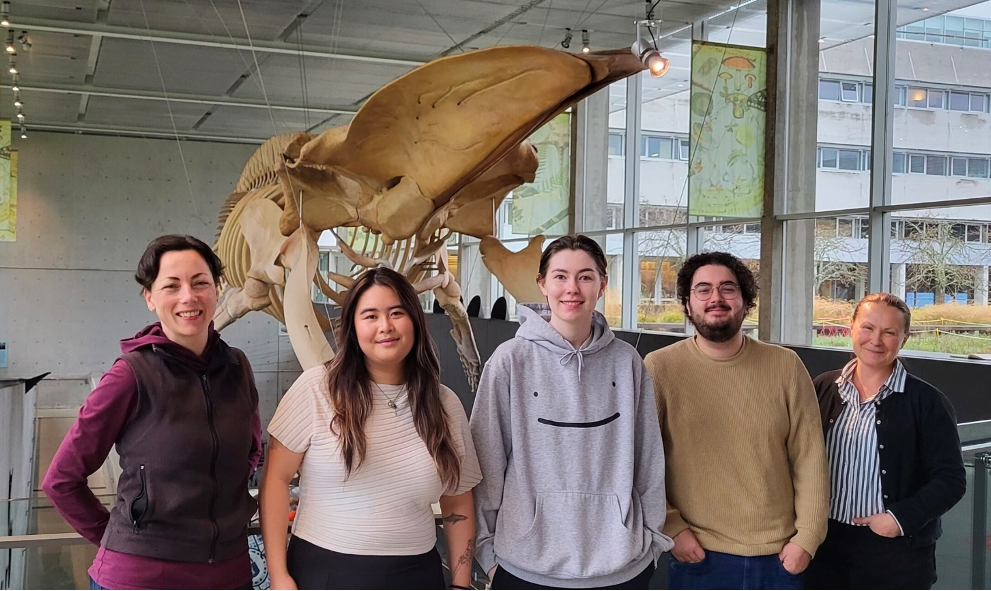
Pictured (left to right): Dr. Bridgette Clarkston, Mailyn Tran, Riley Plunkett, Fabio Peres Schneider, Jackie Chambers. Photo: Deepti Arya
The specimens in natural history collections such as the Beaty Biodiversity Museum (BBM) enrich our understanding of biological diversity through the physical, genetic, and ecological information they contain. As sources of scientific information for the public, museums also play a pivotal role in connecting the community to science. Museum professionals are skilled in teaching pedagogy, communicating contemporary research through hands-on learning, and creating accessible and engaging physical and digital exhibits.
Future biodiversity researchers require hands-on experience with collections-based research in order to be industry-ready. They also need to be effective science communicators engaged in equity and anticolonial initiatives in order to contribute to the communities they serve. An undergraduate course, rooted in collections-based research and modern museum practices will prepare emerging scientists to do this work.
Using this rationale as our guide, the MAKING CONNECTIONS project is dedicated to the development of this new course. Each of our core team members brings a unique set of diverse skills and experiences that have enriched the course’s development immensely. At the heart of our team’s shared values is a desire to develop a course that centers on diverse perspectives, anticolonial practices, and accessibility.
OUR CO-LEADS
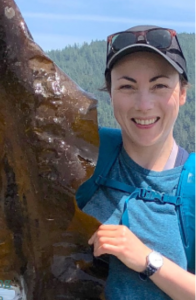 BRIDGETTE CLARKSTON (she/her)
BRIDGETTE CLARKSTON (she/her)
Associate Professor of Teaching, UBC Botany
Bridgette is a seaweed scientist, teaching professor, and a staunch believer that education plays a vital role in making positive change. Bridgette finds the history and practice of preserving biodiversity fascinating and complex and believes that engaging with and learning about biological organisms from the past holds tremendous learning opportunities for students. As an experienced educator who has previously integrated natural museum collections into her classroom, Bridgette guides the team in our pedagogical thinking and curriculum design process. She will be the lead instructor for the new course and looks forward to the impact its teachings will have on the next generation of natural history museum and biodiversity science professionals.
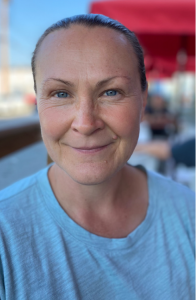 JACKIE CHAMBERS (she/her)
JACKIE CHAMBERS (she/her)
Teaching and Learning Manager, Beaty Biodiversity Museum
Jackie is an ethnobotanist turned museum educator and has led the Teaching and Learning team at the Beaty Biodiversity Museum for the past 11 years. As one of our co-leads, Jackie brings an immense amount of knowledge, and experience with and connection to the Beaty Biodiversity Museum’s collections, personnel, community partners, and education programs. Jackie is excited for the course to be an opportunity for UBC students to connect with the over 2 million specimens and team of museum professionals who are working towards a world where biodiversity is better understood, valued, and protected.
OUR STUDENT CO-DEVELOPERS
The new undergraduate course aims to support the growth and development of the next generation of Natural History Museum workers and Biodiversity professionals, thus the importance of an intergenerational approach to development has always been a priority of the MAKING CONNECTIONS project.
Our three student co-developers joined the MAKING CONNECTIONS project in May 2023 and come from a variety of backgrounds and stages of their academic careers at UBC. Each of them enriches the course’s development through their unique set of experiences, skills, and passions — many of which you can read more about below!
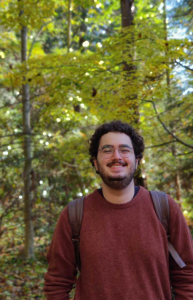 FABIO PERES SCHNEIDER (he/him)
FABIO PERES SCHNEIDER (he/him)
Partnerships Assistant, MAKING CONNECTIONS
Fabio is in the final year of his undergraduate degree in Philosophy at UBC and has been involved with natural history museums throughout his time at UBC. Fabio is excited to integrate decolonial theory, critical Indigenous studies, and the philosophy of science into the natural sciences through the course. As our Partnerships Assistant, Fabio has led our community outreach efforts and the development of resources on anti-colonial, decolonial, and Indigenizing materials for our course.
MAILYN TRAN (she/her)
Project Assistant, MAKING CONNECTIONS
Mailyn is studying oceanography, biology, and climate studies at UBC and is actively involved in ocean-climate research and activism. Mailyn is excited about the potential to educate the next generation of biodiversity professionals on not only the importance and value of Indigenizing their work but also on strategies for how to put such work into practice. She believes long-term environmental monitoring is vital to understanding biological changes in the face of the climate emergency and is excited to highlight the value of the data held in natural history collections and the many museum professionals who manage them for such work through the new course. As our Project Assistant, Mailyn manages the project’s many moving parts, public communication, and event logistics.
RILEY PLUNKETT (he/him)
Evaluations Assistant, MAKING CONNECTIONS
As an undergraduate at UBC, Riley is specializing in oceanography and biology and has focused on science communication and accessibility in his studies. He is passionate about integrating elements of accessibility and inclusivity into the course framework from the beginning to make this course approachable for all students. Riley believes that involving diverse perspectives and centering students in the development process will lead to a more well-rounded and accessible course for everyone, and allow students to appreciate a diverse set of perspectives. Riley’s role as the Project Evaluation Assistant includes designing surveys and feedback stations, data analysis, and ensuring the outlined goals of the project are being met.
MAKING CONNECTIONS: The Explore Phase
Hello again to all our supporters, project partners, and fellow enthusiasts of biodiversity science and natural history! It’s been an exciting couple of months since we first introduced the MAKING CONNECTIONS project, and we’re thrilled to share the progress we’ve made since then.
Our work is made possible by the financial support from the Teaching and Learning Enhancement Fund, and we thank UBC Vancouver students for this! #UBCTLEF
Making Connections:
Our core development team has spent the summer connecting with Beaty Biodiversity Museum curation staff, UBC biodiversity researchers, students, and several other project partners. From the beginning, we have aimed for this course to reflect the diverse set of values, wants, and needs of not only field experts but also of the students who will be taking new undergraduate courses focused on nature history collections and biodiversity science. In turn, our core development team has aimed to act as a central knowledge gatherer between our many project partners, developing the course in a way that serves all.
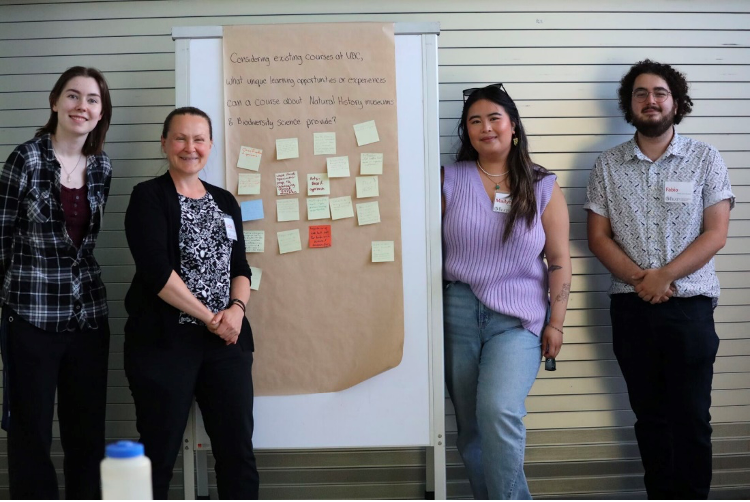
The MAKING CONNECTIONS core development team. From left: Riley Plunkett, Jackie Chambers, Mailyn Tran, Fabio Peres-Schneider; Not Pictured: Dr. Bridgette Clarkston. Photo: Derek Tan
A Student-Centered Learning Experience:
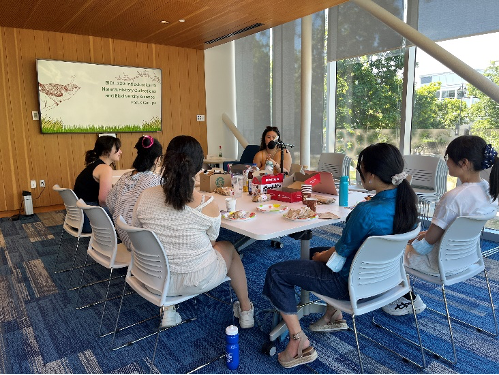
Discussing optimizing learning experiences with UBC students during one of our July focus groups. Photo: Riley Plunkett
Unveiling Perspectives:
Through our work this summer during Phase 1 (The Explore Phase), of our four-stage development process our team has taken the feedback from our project partners and developed our first draft of units. We’ve also begun synthesizing the feedback from students regarding what makes classes most enjoyable and impactful to share with our field experts as we work with them to guide us in content development. We’re thrilled with the progress the MAKING CONNECTIONS project has made — guided by our passion for education, collaboration, and biodiversity science. In the coming months, expect to hear more about the exciting highlights and progress we’re making as we work diligently to create a course that’s both informative and transformative.
Thank you for your unwavering support, and we can’t wait to continue sharing this incredible journey with you all. Stay tuned for more updates!
Warm regards,
The MAKING CONNECTIONS Team
Whale fossil found, marking the discovery of a new species
 Scientists have found the fossilized remains of another giant whale – interestingly from about 40 million years ago, astonishing because previous estimates put gigantism in whales to be a much later development, about 5-7 million years ago. This new find is now shaking up what we know about whales.
Scientists have found the fossilized remains of another giant whale – interestingly from about 40 million years ago, astonishing because previous estimates put gigantism in whales to be a much later development, about 5-7 million years ago. This new find is now shaking up what we know about whales.
In his paper published by Nature on the 2nd of August, paleontologist Giovanni Bianucci shares about this giant whale skeleton his team found in the Ica province, in southern Peru. Bianucci and his team have named it Perucetus colossus. The name aptly is a reference to where they found the bones (Peru), its identification as a whale (cetus), and its size (colossus). One of the keys to identifying whales is the vestigial hipbone, which was found along with vertebrae and ribs. By looking at the vertebrae, Bianucci’s team estimates that the full animal would be approximately 20 meters long. Interestingly though, the estimates for the weight may put the P. colossus over the weight of the blue whale.
The bones found were denser and thicker than typical whale bones in an adaptation known as pachyosteosclerosis. This is typically found in animals that live in shallows and/or with substantial amounts of blubber to resist the cold. This thickening was found in all of the bones recovered. The vertebrae were found to be almost twice the thickness of the vertebrae of a blue whale. The comparison to the now-extinct Stellar’s sea cow and other sirenians has been made, in terms of bone density which emphasizes the theory that this animal could have been a diving whale that occupied shallow waters. This adaptation allows for the weight necessary to dive for prey and to hold enough fat to resist cold waters – important as the dating places this whale during a period of global cooling. Regardless of the current estimates, many researchers are doubtful if P. colossus was truly heavier than the blue whale.
Behaviorally, there is little that can be confirmed by the fossils. There were no pieces of the skull found to confirm diet, but it has been hypothesized that this whale likely fed on fish as was typical for early whales or crustaceans because of its supposed diving capabilities. This is, of course, all speculation.
Although there is much to still be discovered about this new species, it is exciting to find an individual so outside of our understanding of whale evolution.
References:
Bianucci, G., Lambert, O., Urbina, M., et al. A heavyweight early whale pushes the boundaries of vertebrate morphology. Nature (2023).
https://www.cbc.ca/news/science/perucetus-whale-fossil-heavy-1.6925284
https://www.reuters.com/science/ancient-whale-peru-may-be-most-massive-animal-ever-earth-2023-08-02/
MAKING CONNECTIONS: A New Approach to Teaching Biodiversity Science
The MAKING CONNECTIONS project is a collaboration between the Beaty Biodiversity Museum (BBM) and faculty from Forestry, Botany, Zoology, and Earth, Ocean and Atmospheric Sciences. Based at the BBM and working in collaboration with students, researchers, and museum professionals, MAKING CONNECTIONS is a cross-departmental team working on developing educational units for a new biodiversity science course focused on natural history collections and science communication.
The MAKING CONNECTIONS team is excited to be working on a brand new UBC undergraduate course that will appeal to a diverse group of UBC students and will be open to upper-year students from any faculty, with no required prerequisites. We gratefully acknowledge the financial support for this project provided by UBC Vancouver students via the Teaching and Learning Enhancement Fund #UBCTLEF.

Gathering ideas and feedback at the MAKING CONNECTIONS Project Kickoff event in June 2023. Photo: Derek Tan
How will this course differ from others?
As UBC’s first course with a specific focus on natural history collections, the goal is to expose students to the world of natural history museums and all the work that happens behind the scenes within them. The course will highlight the value of natural history museums and their collections to science communication, community outreach, biodiversity research, and conservation. Students will have the opportunity to interact with the Beaty Biodiversity Museum’s research collections and learn valuable career skills from curators, researchers, and guest lecturers.
The new course development process is also quite unique; its development is student-driven, and the course has been allotted two full years to be developed! This extended development period provides the development team the opportunity to thoroughly consider a wide range of perspectives and build the course from the ground up with the express intent of highlighting diverse perspectives and Indigenous knowledge. This new course will reflect the voices of a variety of groups interested in topics related to both natural history museums and biodiversity science through partnership, consultation, and outreach with student groups, Indigenous leaders, museum staff, industry professionals, and biodiversity researchers.
Stay tuned for more highlights as the course develops!

Conversation and connection are important to the course development process. Image from the MAKING CONNECTIONS Project Kickoff event in June 2023. Photo: Riley Plunkett
Beaty Biodiversity Centre Expansion Project

Things are changing at the Beaty! A significant expansion to the Biodiversity Research Centre, located next to the museum, will be happening this spring. The construction period starts in April 2023 and the conclusion will be in spring 2025. As with any major construction project, we anticipate delays and unforeseen circumstances – we may need to cancel or change our bookings and rentals at short notice. We thank you for your patience as we undergo this exciting transformation!
The Beaty Biodiversity Museum will remain open during the expansion period, and operations will continue as normal.
What to expect:
During the construction period, visitors can expect some noise and occasional changes in access points. There may be times when the museum will have to close, and we may have to cancel bookings and scheduled programming at short notice. We will endeavor to provide the public with as much advanced notice as possible of any closure dates using our social media and website.
About the expansion project:
The proposed expansion of the Beaty Biodiversity Centre will be a 4,430 sq. m. 6-story laboratory and office addition to the existing building that will provide space for researchers, museum collections and supporting functions, and meeting and gathering spaces.
The building is on Main Mall, an important part of the campus, and will be situated adjacent to Fairview Grove, a valued green space. The proposed addition is east of the grove away from Main Mall. Considerable planning has gone into the design of the landscape to address the loss of trees through the enhancement of the grove and connecting the ecology of this site to adjacent natural, cultural, and ecological systems.
Click here to read more about the Beaty Biodiversity Centre expansion.


